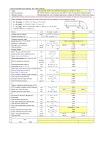(i) Soldering :-
This joint is made on thin metals using solder as a joining medium. The melting point of solder is less than the metals to be joined. The joint can be opened by heating upto the solder melting temperature (below 400°C).
(ii) Brazing :-
The joint is similar to soldering but has more strength. The joining medium used is brass, which has a higher melting temperature than solder. The joint can also be opened by heating upto the melting point of brass (850-950°C).
(iii) Welding :-
A metal joining method in which the joining edges are heated and fused together with or without filler metal to form a permanent (homogeneous) bond is known as welding. Or in other words, “Welding is a process of joining two or more pieces of the same or dissimilar materials to achieve complete coalescence. This is the only method of developing monolithic structures and it is often accomplished by the use of heat and/or pressure.
Joining methods like riveting, assembling with bolt, seaming, soldering and brazing all result in temporary joints. Welding is the only method to join metals permanently.
The temporary joints can be separated if: -
- The head of the rivet is cut
- Nut of the bolt is unscrewed
- Hook of the seam is opened
- More heat is given than that required for soldering and brazing.
Welded joints cannot be separated like soldering and brazing because it is made homogeneous by heating and fusing the joining edges together.
Welding is superior to other metal joining methods because it:
- is a permanent pressure tight joint
- occupies less space
- gives more economy of material
- has less weight
- withstands high temperature and pressure equal to joined material
- can be done quickly
- gives no colour change to joints.
It is the strongest joint and any type of metal of any thickness can be joined.








-page-001.jpg)




0 Comments